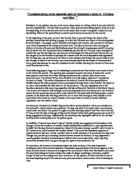How effective is Steinbeck’s use of symbolism in Chapter 3 of ‘Of Mice & Men’?
In chapter 3, the setting, the bunkhouse can be seen to symbolise that people only see what is obvious to them. Steinbeck shows this through symbolism in the bunkhouse.
‘Although there was evening brightness showing through the windows of the bunkhouse, inside it was dusk… Instantly the table was brilliant with light, and the cone of the shade threw its brightness straight downward, leaving the corners of the bunkhouse still in dusk.
The brightness down the centre of the bunkhouse shows our assumptions about something, as we judge things solely for what we see and know. This happens at least once during the text and can be seen through the immediate judgement of Curley's wife as comes alone to the bunkhouse. George seems to know exactly where the trouble is going to originate, and this is shown when George cautions Lennie not to talk to Curley's wife. George immediately judges Curley’s wife from previous gossip from Candy, her appearance and her behaviour before he has a chance to get to know her. His assumption led the audience to believe that she is simply just a tart, and nothing more. The dark and gloomy corners on the other hand are a representation of the secrets and not so obvious things in life. This can be seen at the end of the text when we find out the real reasoning as to why Curley’s wife behaves the way she does, which is due to her lack of attention from Curley, not just because she is a floozy. The contrast of dark and light builds anticipation in the audience as the feeling of doubt seems to lurk permanently in the background.









